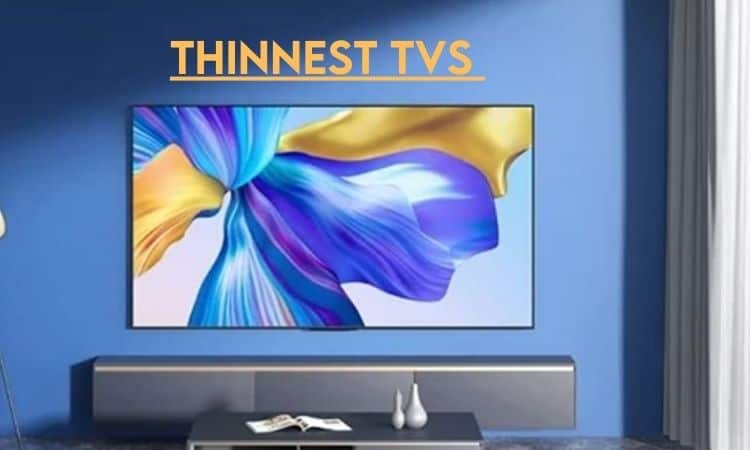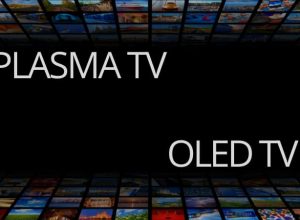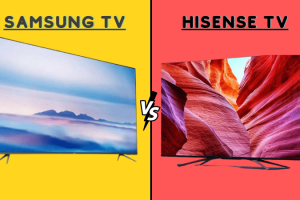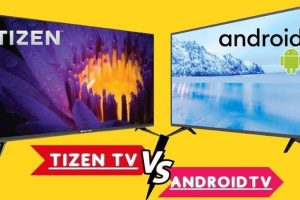It is expected that various TV technologies (i.e., LG Nano cell vs Samsung QLED) and TV models will confuse people during the buying process. Yes, You want to buy a new TV with the latest tech. You have numerous choices before you. You are not an exception if you are overwhelmed by ever-changing TV technologies. We often encounter such people.
Famous TV manufacturer LG introduces Nano cell technology, while QLED TV is the renowned product of Samsung. Nano cell and QLED TV techs vary not just in display panels but in numerous other specifications as well. This involves complex technical terms. Don’t worry. We kept it simple. You will be able to decide as per your requirements.
You may prefer relatively economical LG Nano cell TVs for their less energy consumption, wide viewing angles, less burn-in issues, accurate colors. You should go with Samsung QLED TVs if you are keen to have a wide color range, better brightness and image quality. You can also test the latest LG OLED TVs, which combine Nano cell and QLED TV techs.
We have prepared this article after detailed research work with the guidance of TV technology experts. So you don’t need to look elsewhere. Be happy. You are in the right place to get accurate information. You will be able to know everything in detail in simpler terms. After reading the entire article, it would be best if you made a personalized choice.
The Technology Difference and Working Mechanism for LG Nano cell Vs Samsung QLED TV
As promised, we will keep it straightforward. So, everyone can extract what they are looking for even with a basic know-how of technology.
What is the technology used in Nanocell TVs?
LG Nano cell TV incorporates nanoparticle filters for backlighting the TV panel behind the LCD. These nanoparticles ( having a size equal to 1 nanometer = 1nm = 10^-9 m) help to provide better colors and remove all sorts of impurities in the picture.
Thus a picture in the purest primary colors, i.e., green, red, and blue, is produced. So, Nano cell TVs are slightly better if you want rich colors.
Remember that nanoparticle technology is the patent of the LG brand, and no other brand can use this technology. So, it is good to mention the brand name and relevant technology, i.e., LG Nano cell TVs.
Check our guide on the best TVs under $600.
What is the technology used in Samsung QLED TVs?
QLED TVs use the quantum dot filters (small lightning spots), which are very small, i.e., 20000 smaller than a human hair. Because of this, thousands can be aligned on the back side of limited screen space.
Note that Samsung mainly uses quantum dots technology, so it is custom to mention the brand name and Technology as Samsung QLED TVs.
Precisely speaking, quantum dots are microscopic and emit various colors (not just primary colors) after being struck by light. Thus backlighting phenomena occur. The size of quantum dots varies, and every size produces a different color. Hence the contrast ratio and brightness are better in the case of QLED TVs
Also, check our guide on the best TVs for darkrooms.
Detailed Comparison of specifications between LG Nano cell Vs. Samsung QLED TVs

What makes you confused? Probably, you may get confused about the suitability of technology’s specifications for different tasks in specific surroundings. You need to know the specifications of both Nano cell TVs and QLED TVs to decide which one satisfies your requirements. With such an approach, you will avoid regret. These details should be sought for the specific model of Nanocell Vs. QLED, which you intend to buy as the devil, is.
As in Nano cell TVs, nanoparticles filter dull colors and show off light in the brightest colors, but the quantum dots emit light of every wavelength, i.e., flush. Both have an excellent picture quality, but nano cells are slightly better.
Regarding contrast ratio, the QLED TVs have exceptionally high contrast ratios compared to Nano cells.
You are probably buying a TV for your recreational or entertainment room, and the seating arrangement is such that some of your audiences are off center and have to look at a TV at skewed angles. In such a case, a smaller-sized QLED TV might be problematic for you. So, we advise you to choose Nano cells having wider viewing angles.
Dimming and proper management of reflections is the key while watching TV in brighter or darker surroundings. Nano cell TVs are the better choice in a brilliant and well-lighted room as they effectively manage light reflections. But for a darker room, we suggest you go with QLED TVs.
People like durable and long-lasting electronic devices. The same is the case with TVs. Nano cells have fewer burn-in issues even if kept on for a prolonged time compared to QLED TVs.
Some people might object to placing “Price” in the specifications column. We hope you should never mind it. In our opinion, price consideration is the most vital specification. It will let us know about our buying limits. So, in the present case of Nano cells Vs. QLED and Nano cell TVs are cheaper than QLED TVs of equivalent models.
Moreover, the following Table will summarize all specifications shortly.
You probably got a brief idea about the Comparison of key specifications, including Picture quality, Viewing Angles, and Reflections for both Nano cell and QLED TVs.
But these three specifications mentioned above will need your special attention as they might prove deciding factors for buying a new TV. We will discuss them one by one.
The difference in Picture Quality between LG Nanocell vs. Samsung QLED TVs
Yes, the difference is significant. As we all know, pictures are formed by colors. Where do these colors come from? The answer to this question is different for Nano cell and QLED. It is because of the root difference in backlighting technology of Both Nano cells Vs. QLED TVs.
You might have already grasped the idea of nanoparticle filter technology which filters all other colors except pure primary colors, i.e., green, red, and blue. Thus the picture becomes rich and pure in color, having no dull colors whatsoever. But this filtering process lessens the brightness and contrast for Nano cell TVs, thus making them less acceptable for a dark room.
But the Quantum dots of QLED emit light of every wavelength. So, it produces a bombardment of colors, and brightness is significantly increased. In the case of QLED TV, the picture quality lowers a bit as colors are not as pure and rich as in the case of Nano cell. So, for a dark room, QLED is the obvious choice. But if you crave pure, rich, and excellent colors, then your first choice should be Nano cell TV.
Hurrah! Recently LG introduced
new QNED TV models use both Nano cell and quantum dots technologies. Thus QNED TVs show pure and rich colors like Nano cell along with the enhanced brightness like QLED TVs. Therefore you can have two in one. But you should check the price yourself. It may awe you a little bit. Nothing to worry about. Excellent things are always expensive.
How well does LG Nanocell vs. Samsung QLED TVs manage reflections?
Suppose you may want to watch TV in an open space during the day, or you need a TV for a well-lit bright room. So, never forget the reflections of light rays on the TV screen. If not closely considered, the thoughts will undoubtedly destroy your TV enjoyment.
LG Nano cell TVs usually show excellent reflection management due to their different panel design. The reflections hardly affect picture quality in the case of Nano cell TVs. Hence, the Nano cell technology is the perfect solution for a bright, well-lighted room where the TV screen will encounter numerous light reflections.
QLED TVs show poor reflection management due to the effect that QLED TVs offer excellent brightness, which, coupled with reflections, becomes problematic. But the advantage of QLED TVs is obvious for poorly lighted dark rooms.
Why is it so? It is due to the difference in panel technology and color scheme between Nano cell Vs. QLED. The Panel Technology is briefed in detail under the following heading.
Also, check our guide on the best antiglare TVs.
Effect of Panel Technology on Viewing Angles for LG Nano cell Vs. Samsung QLED TVs
Let’s say you have limited space and all of your friends can not sit in front of the TV screen or you require a prominent contrast. In such a case, the difference in the screen panel is crucial. The panel difference between Nano cell vs. QLED is a significant factor.
In Nano cell TVs, the IPS (In-Plane Switching) Panels are used. In IPS panels, the crystals are arranged parallel to each other. With IPS technology. The parallel alignment ensures a similar picture quality experience at skewed viewing angles. In other words, viewing angles become more expensive in the case of IPS panel technology.
The downside of IPS panels is that they don’t work well in very dark rooms as it leaves a dark grayish stitch on the screen. So, for dark rooms, the QLED panel technology suits you well.
In QLED TVs, the VA (Vertically aligned) panels are incorporated. A vertically aligned meeting will get perfect black and improved brightness with excellent contrast. Thus making QLED TVs a good choice for dark surroundings.
But the disadvantage of the VA panel is also worth considering. Due to specific VA alignment, the picture quality and colors get dull for persons sitting on the edge of Couches or sofas, and they are not exactly in front of the TV screen. Yes, you got it right. In this case, the viewing angle gets narrow.
So, for a better viewing angle, choose Nano cell TV and for enhanced brightness, go for QLED TV, especially for very dark rooms.
Also, check our guide on what type of TV has the best viewing angles.
LG Nanocell Vs. Samsung QLED TV: Which is best for gaming, Movies & Series
Generally speaking, both LG Nanocell and Samsung QLED TV are best for gaming. But in Nano cells, low input lag facilitates the gamers as it enables upscaling.
What does it mean to be upscale? Let me clarify that. Upscaling is the TV’s ability to work with a lower definition/pixel input signal (say 720p) by enhancing it to the ultra-high definition (say 4k UHD) quality.
Samsung QLED TVs are also perfect for gaming, providing excellent picture quality with greater brightness and contrast. It proves to be a fantastic experience.
If you are still confused, you can review the specs of any Nano cell or QLED model. Look for the advanced features necessary for gaming purposes. Hence you will be able to decide which model of Nanocell or QLED suits you the most.
You are setting up your home theater for watching movies and TV series. You will have a large audience. So, remember viewing angle consideration. So that all of you enjoy it equally. The room’s lighting will also help you the best.
LG Nano cell will be the appropriate choice in a well-lit room with a packed audience. The space is a little dark if you want to create a cinema-like environment. In such surroundings, we recommend you QLED in a bigger size, giving you extra brightness and sufficient viewing angle.
TV Features: LG Nanocell Vs. Samsung QLED TVs
You might want more than 3 HDMI ports in your TV, or your concern is the more USB ports, or you may prefer to use Bluetooth while connecting with the TV. A close look at the features of both technologies will give you information about these and other critical components.
Although we may prefer a technology, either nano cell or QLED, over another, it is not merely the technology that matters.
But the size, resolution (HD or 4k UHD), Variable Refresh Rate (VRR) and TV Frequency, Response Time, HDMI ports, USB Ports, Bluetooth feature, and Google assistant availability also matter.
Most Nancell and QLED TVs have more than 3 HDMI ports in a bigger size. They have sufficient USB ports as well. However, it would be best if you had more. You can buy an HDMI Hub from the market. LG Nano cell and Samsung QLED TVs are available in every size ranging from 43 to 97 inches, except LG’s latest smaller 42-inch OLED TV.
The modern TVs of Both LG Nano cell and Samsung QLED have 4K Ultra High Definition (UHD) resolution, 120 Hz frequency, Bluetooth feature, and Google Assistant.
Response time for QLED TVs is slightly higher than Nano cell TVs. VRR feature is available in all Nano cell TVs and most the QLED TVs.
Minute details may vary for different TV models of Nano cell and QLED. So pay special heed to features while buying a new TV.
The Price Consideration for LG Nanocell Vs. Samsung QLED TVs
The price is already discussed briefly in the specification table. But you could never wind up this discussion as every choice depends upon the money that you have in your pocket.
Everyone wants to enjoy the best picture quality, rich colors, customized features, suitable viewing angles, excellent contrast, and enhanced brightness in a bigger size with the latest cutting-edge technology.
Oh no, you are not in heaven. Nothing comes for free in this materialistic world. You have to earn every penny. Thus, budget constraints filter our preferences to a greater extent.
But please don’t be sad. You still have numerous TV models in both Nano cell and QLED Technology for different prices in the market. You can quickly identify your requirements and match those with some excellent models in the market, obviously within your budget range.
We will not mention exact prices as these keep changing in different state markets. You may check their prices on online shopping platforms such as Amazon. But we will try to put you on the right course while considering pricing and convey the right concept for budget consideration.
LG Nano cell TVs have a relatively lower price than QLED TVs of equivalent model. Different TV models of LG Nanocell and Samsung QLED are mentioned in the Table below in the next heading. The most expensive and latest model is placed at the bottom.
However, every new model has a price hike for both Nano cell and QLED TVs. It is recommended that you should not alter your technology preference just for pricing reasons.
So, first, decide the most suitable Technology between Nano cell Vs. QLED. You may go with a TV model of your desired technology that is not very latest or obsolete. Thus the price will be reasonable, and you will enjoy TV with your chosen technology.
Advantages of NanoCell TVs
The NanoCell TVs have better viewing angles. Because of this, you are able to experience high-quality visuals regardless of the angle from which you see the screen.
On the other hand, The IPS panel used in NanoCell TVs produces blacks that are not as consistent nor deep as those produced by other panels.
When you compare an IPS panel to a VA panel, you will see that the brightness and contrast are both improved. In addition to this, IPS panels have improved anti-glare capabilities.
For this reason, it is preferable to watch your preferred television programs or movies throughout the daytime on these screens because they are better able to combat the effects of light.
The response time of the NanoCell TV is superior to that of the QLED TV, which is another advantage of the NanoCell TV. As a result, it is more successful in eliminating motion blur, which ultimately results in a more life-like viewing experience.
Advantages of QLED TVs
One of the most important reasons to choose a QLED TV over a NanoCell is that it uses VA screens. Because of the display, the television can produce images with strong contrast, superb brightness, and deep blacks. These aspects contribute to the improvement of the HDR content.
However, the TV does not have the finest viewing angles compared to other options available. When you tilt the screen just a little bit, the colors’ saturation and brilliance get distorted.
Therefore, if you look at the screen from certain angles, you won’t be able to appreciate the highest possible picture quality.
In addition, in order to experience the very finest picture quality, you will need to adjust your QLED TV to a certain preset. If you do not use the settings, the colors on the screen will become oversaturated
Does the TV model or brand matter?

LG Nanocell and Samsung QLED TVs have many models, with more and more features added through each new model. Newer models of both technologies are expensive. Yes, the specific Nano cell or QLED TV model has distinct characteristics. For example, Q60A has only edge backlighting while QN90A has a much-improved mini LED system backlighting. So you should consider the details about different models while buying a new TV.
Let’s summarize a few latest models of Nano cell and QLED TVs
The question about a brand is also vital for you to consider. If you are satisfied with Nano cell technology, then you have the single choice of LG brand because Nano cell technology is the patent of the LG brand.
But for QLED TVs, you can choose the desired brand. The leading and most recommended is Samsung due to its better quality and class. But QLED TVs are also available in TCL brands.
Conclusion: Best Choice between Nanocell Vs. QLED TV
We kept it so simple that everyone could grasp the specifications discussed in the article. You can make an informed decision between LG Nano cell Vs. Samsung QLED TV as per your requirements.
As explained in detail, the tech of Nanocell TVs consists of tiny nanoparticles coupled with various filters. QLED (Quantum Dots Light Emitting Diode) TVs consist of Quantum dots tech. Moreover, the effect of tech is discussed on TV specifications and features, along with the suitability of Nanocell Vs. QLED TVs in different environments.
It is clearly illustrated that you must assess the requirement and purpose of buying a new TV. Different choices are discussed for various purposes. You want perfect colors for a dark room or the best viewing angles for a large audience. Your concern might be the best TV for gaming purposes. So, choices differ a lot.
But as a final word, we will let you know our opinion on given situations and environments. You may prefer relatively economical LG Nano cell TVs for their less energy consumption, wide viewing angles, less burn-in issues, and pure colors, especially for well-lit rooms.
You should go with Samsung QLED TVs if you are keen to have a variety of colors, better brightness & contrast in dark rooms. You can also test the latest LG QNED TVs, which combine both Nano cell and QLED TV techs to enjoy both advantages.
It is impossible to suggest the best choice for all of you as you all have different preferences and requirements. We encourage you to go through the entire article to decide the personalized best option for you.
FAQs
What are the critical differences between Nano cell Vs.? QLED TVs?
The critical difference is the different techniques used for Nano cell Vs. QLED. Nano cell uses Nano cell tech, which consists of nanoparticle filters of the same size. These nanoparticles produce pure green, red, and blue colors while filtering out impure and dull colors. Thus pure colors with good reflection management with wide viewing angles are features of Nanocell TVs.
While in the case of QLED (Quantum Dots Light Emitting Diode) TV, Quantum dots of different sizes are used. These quantum dots emit light of different wavelengths, i.e., varying colors. Thus a large volume of colors ensures better brightness and contrast.Which is the better choice between Nanocell Vs. QLED TVs?
The technology involved in Nano cell Vs. QLED TVs have their pros and cons. But these different techs try to achieve the same objective of showing realistic colors on a TV screen.
Due to inherent differences in technology, their specifications also vary. Thus choice will certainly depend upon what you are looking for. So, your personal choice will relate to your preference for the best option.
You may prefer relatively economical LG Nano cell TVs for their less energy consumption, wide viewing angles, less burn-in issues, and pure colors, especially for well-lit rooms. Your choice can be the Samsung QLED TVs if you are keen to have a variety of colors, better brightness & contrast in dark rooms. You can also test the latest LG QLED TVs, which combine both Nano cell and QLED TV techs to enjoy both advantages.How will you compare Nano cells with QLED and OLED TVs?
OLED (Organic Light Emitting Diode) TVs are the latest technology manufactured by LG. In these OLED TVs, the backlighting mechanism is such that each pixel can be turned on or off independently. Advantageously, it removes any blur on fast movements. OLED TVs will have better viewing angles as compared to QLED.
So, it can be said the OLED TVs class involves a high-profile tech. Thus it produces better results than Nano cell and QLED TVs. But do remember OLED TVs are generally more expensive.
Jason Reynolds
I have been working in the electrical and Audio/Visual field for over 19 years. My focus for EagleTVMounting is to provide concise expertise in everything I write. The greatest joy in life is to provide people with insight information that can potentially change their viewpoints. Our #1 goal is just that!







![Best Smart TVs Under $200 10 Best TVs Under $200 in 2022 [Smart, 4K, Top Rated]](https://eagletvmounting.com/wp-content/uploads/elementor/thumbs/Best-Smart-TVs-Under-200-1-pxsvk5gy9n9zpv0lrzhk644n1gvwdxv32ixo8gyqoo.jpg)


